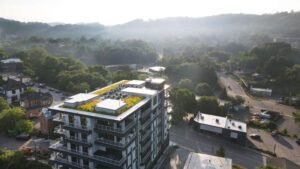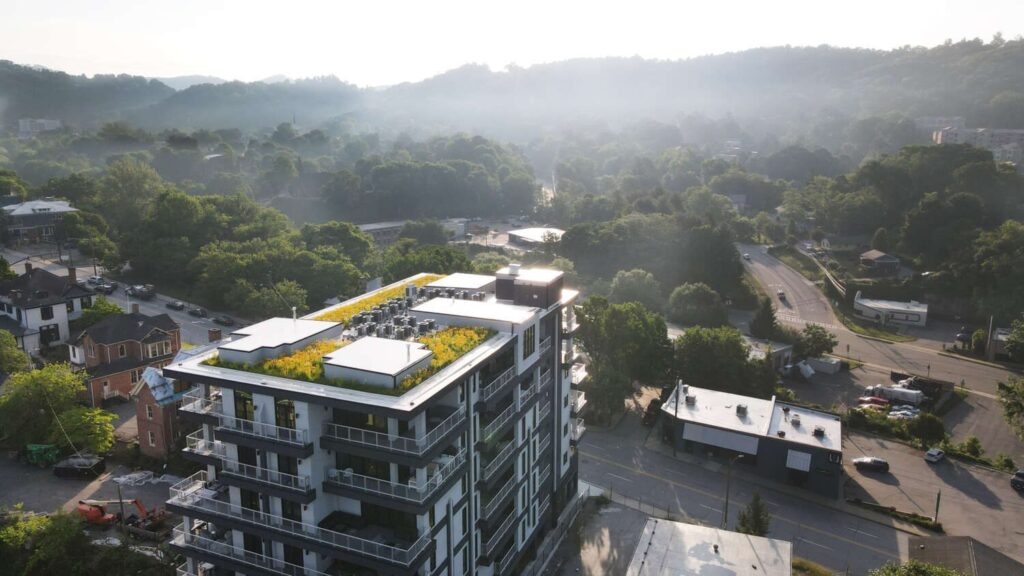On the third-floor terrace of Mission Hospital’s North Tower, patients and staff can take a lunch break or respite amid a sun-dappled ornamental garden, while savoring westward views of Mount Pisgah and the Blue Ridge Mountains.
It’s a big step up from the previous alfresco break space, which was essentially the parking lot. Having that connection to nature and beauty that the living environment provides is an obvious enhancement.
A lot of people think of a green or living roof as an amenity, says Kate Ancaya, who, along with her partner, Emilio, own Asheville-based Living Roofs Inc., one of only two companies in the Southeast that specializes in green roof design and installation.
They installed a living roof at the hospital and on dozens of other residential and commercial properties across the Southeast, but beautification, Kate says, is merely a superficial benefit of what a green roof can do for a city as a whole.
Living roofs as green infrastructure
Green roofs can play a crucial role in a city’s infrastructure — in both its ability to manage stormwater and also safeguard the environment to the benefit of all. It’s also an energy and cost-saving measure for building owners.
As climate change brings increasing precipitation to parts of the planet, and urbanization increases the square footage of impermeable surfaces, managing stormwater is a pressing concern for many cities, including Asheville. A major rain event can overwhelm existing (and often outdated) conventional stormwater infrastructure, forcing overflow water into sewer systems and roadways, where it picks up all sorts of nasty pollutants before heading into our waterways, poisoning the environment in the process and, in some instances, causing massive flood damage.
Green infrastructure — meaning design solutions that work with nature’s natural processes such as rain gardens, bioretention ponds, and living roofs — helps reduce stormwater runoff by absorbing water and filtering pollutants before entering waterways. These nature-based solutions work in tandem with gray infrastructure (i.e. pipes, dams, and other engineering that strives to control nature). Both forms of infrastructure have a role to play, though, according to the EPA, shifting toward more green infrastructure is the future of climate resilience.
“Green roofs are the first line of stormwater capture in urban areas,” Kate said. “They can absorb and divert as much as 80 percent of a structure’s stormwater runoff, and reduce the rate at which water leaves the roof, which decreases pollution, flooding, and erosion during rain events.”
Green roofs also help reduce urban heat, lower a building’s energy demands, increase biodiversity, and improve air quality.

The approach to green roofing as infrastructure was the goal of one downtown Asheville project executed by Living Roofs, which is the condo development at 145 Biltmore.
Unless you’ve got a perfectly angled vantage point, you’d hardly know the building’s roof was an expansive meadow of grasses and perennials, interspersed with big humming metal boxes housing HVAC and other mechanical systems. Even those who live in the building don’t get access to this little oasis. That’s because it exists specifically to reduce stormwater runoff.
As the engineer on the project, Chris Day of Civil Design Concepts was tasked with maximizing the building’s footprint. He also had to adhere to the City of Asheville’s federally mandated stormwater requirements, which call for installing permanent measures to control the volume of runoff in an effort to reduce pollutants and flooding. By incorporating a green roof, Day was able to avoid a subsurface stormwater containment system and repurpose the saved space for needed parking.
“They were thinking about it early on,” Emilio said. When clients or architects and engineers on a project have the forethought to consider a green roof as infrastructure and collaborate early on in the design process, Emilio says, he and his team are able to design in a way that meets the project’s budget and goals. Determinations also need to be made early on as to whether the structure is designed to hold the green roof’s extra weight.
For this specific development, covering only a portion of the building with a living roof system was necessary to meet the city’s stormwater permit requirements. There was much to be gained, though, from covering the majority of the roof with plants. As added benefits, the green roof would also lower the building’s energy demands by shading the surface and reducing indoor temperatures, and would extend the lifespan of the roofing by insulating it from temperature fluctuations, UV rays, and exposure to the elements.
So the Living Roofs’ team came up with a cost-efficient solution. Rather than using a costly modular pre-vegetated system, they proposed a traditional layered system and planting approach that used a mixture of plant plugs and seeds while still achieving the goal. And to seal the deal, they were also able to convey the additional ways the new green roof could serve the greater good.
Addressing heat and creating habitat
Green roofs help reduce what’s called “urban heat island effect,” which occurs in concrete-dense cities where pavement, buildings, and other surfaces absorb and retain heat. It’s how cities like New York or Chicago can suffer deadly heat waves.
“People can relate to that here in Asheville,” Emilio said. “You can be downtown and then drive out to Bent Creek and tell the difference.”
With climate change, rising temperatures and heat waves are expected to increase in frequency and duration. But green infrastructure like urban gardens, trees along city streets, and living roofs can help cool down these concrete jungles, and cooler cities make for more pleasant and healthier places to live and visit.
Another added benefit is biodiversity. Living Roofs uses native and ornamental grasses and perennials they know will thrive in the specific conditions. It’s why they don’t often use succulents and sedums commonly associated with living roofs, since those plants prefer hotter, drier climates. By incorporating a diversity of native plant species, the living roof is able to support native pollinators that sustain our environment and food supply. Imagine a city filled with living roofs, Kate says, and you’ve got the potential for corridors that can provide habitat, food, and refuge for native and migrating species.
“Urban areas actually have a great opportunity to boost biodiversity,” Kate said. “In some cases, even more so than some rural and suburban areas with expansive turf or acres of monocultures, such as farmland that’s dominated by a single crop.”
Additionally, the plants also serve to filter pollution and particulate matter out of the air, thus improving air quality.
There are also social, community-based benefits as well. By installing more living roofs, we are contributing to a more climate resilient future that everyone will benefit from. And for those living roofs that are accessible to people, that connection with nature promotes overall well-being and health. Indeed, the aesthetics are a benefit as well.
Melissa Reardon is an Asheville-based freelance writer and former editor-in-chief for WNC magazine. She pens and publishes stories about travel, adventure, food and beverage, arts, culture, and architecture. See more of her work at melissareardon.com.
145 Biltmore Project Team:
Green Roof Design and Installation — Living Roofs Inc.
Architect — MHAworks
Engineer — Civil Design Concepts
Builder — Beverly Grant
You can also view this article as it was originally published on page 26 of the 2022-23 edition of the directory.


